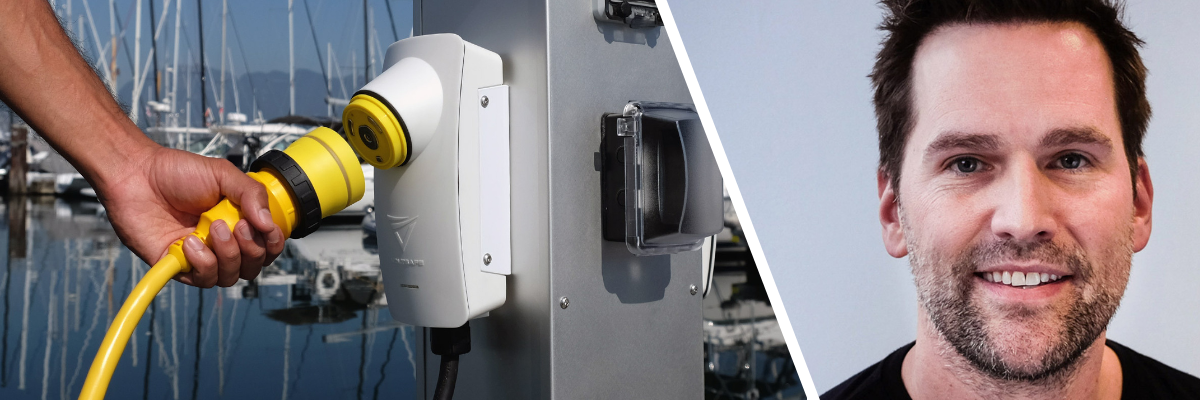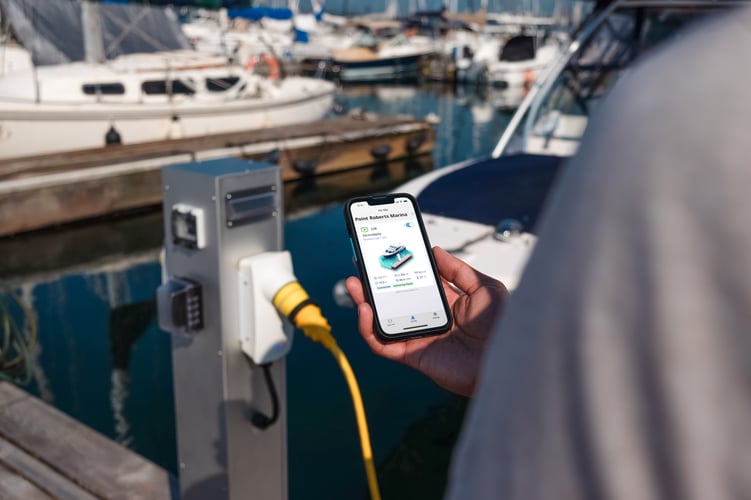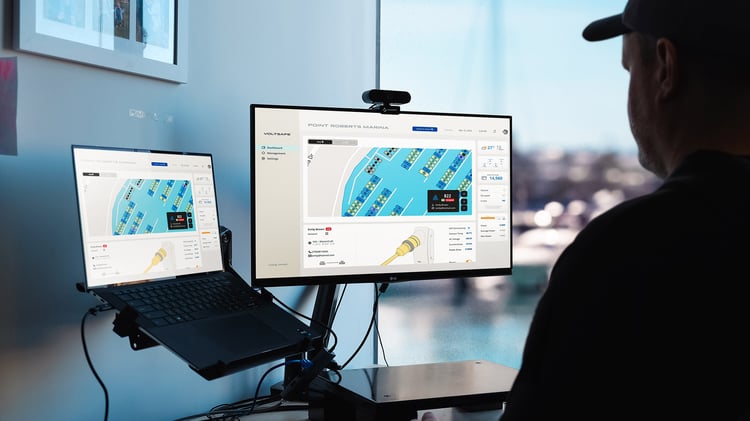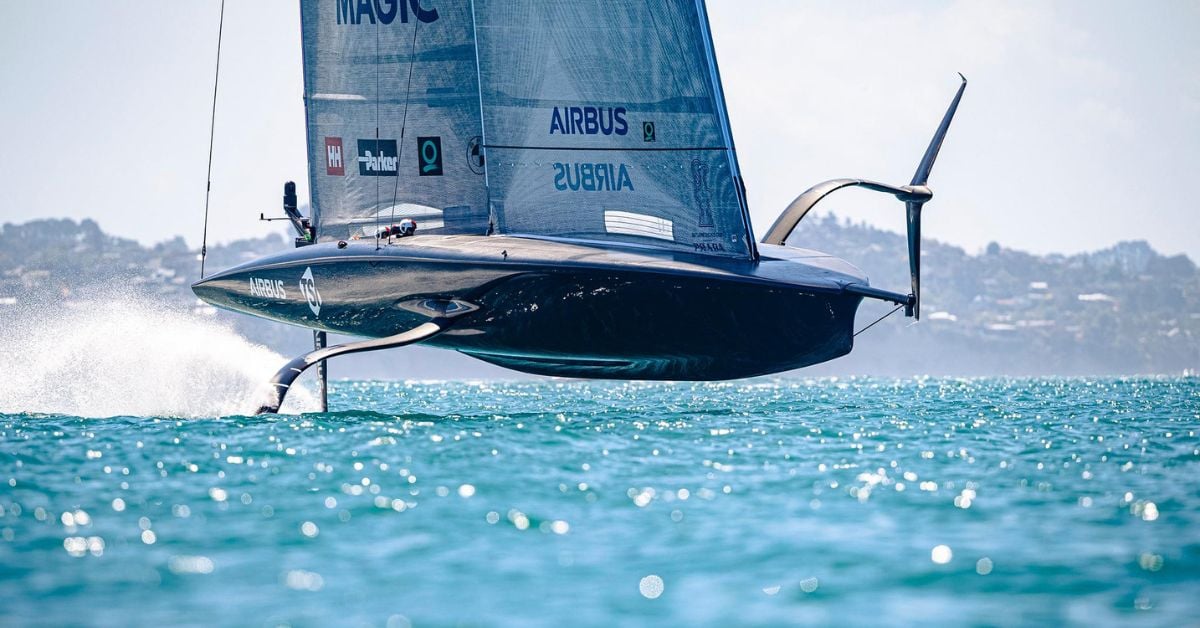Revolutionizing energy connection: VoltSafe's magnetic electric plugs transforming safety and efficiency
 Hans Buitelaar
Hans Buitelaar
Save energy by using it smarter. Canadian start-up VoltSafe created an electricity connecting plug that is safer, easier, provides information on energy use and can be applied to minimise the use of energy. CEO and founder Trevor Burgess shares his vision.
First time you connect a VoltSafe plug, it feels a little strange. There is a 40 pound magnet-ic force pulling your arm when the plug comes close to the connection plate. Then it con-nects and electric power can charge batteries or power domestic equipment aboard your boat.
The considerable magnetic force that connects the plug to the socket is strong enough to prevent the plug disconnecting if somebody would accidentally bump into it. Yet, it is easy to unplug by twisting the plug only 20 degrees. Then the polarity of the natural earth mag-nets becomes opposite and you will actually feel the plug being gently pushed towards you. Still, if you were to hold the plug in front of the connecting plate, it would automatically find the attracting polarity and connect.
The disconnecting twist needs to be a deliberate action. The VoltSafe connector automati-cally cuts the electricity supply when there is no connection. People can touch the exposed metal parts of the connector without any danger: the voltage is not ‘live’ at the outside of the connector. This is also the case with the plug: if it is connected to your boat’s electric system and you walk towards the electricity pedestal, the power only gets flowing after the connection with the socket is established.
A chip inside the connector is programmed with an algorithm that will connect through a WiFi signal with the marina manager’s computer and also with the slip owner’s smartphone. An app shows the rate of energy being used and the amount of kiloWatts supplied.

VoltSafe's Marine Companion app
Stop
“Our magnetic electric power connector solves a number of issues that exist using conven-tional prong plugs to connect your boat to shore power,” VoltSafe CEO Trevor Burgess as-sures. The new plug system is safer. Not only is the voltage cut off when no plug is con-nected, the system also detects leakage of current and will stop electric power when this is the case, preventing energy loss and also preventing electric shocks to people that go over a wet boardwalk.
VoltSafe connectors are also easier, Burgess reasons, referring to the magnetic connection. With LED lights installed, the connector is easy to find in the dark. In marinas, the connect-ors can even be equipped with wayfinder lighting to illuminate the boardwalks.
Overview
The VoltSafe connector also allows for energy savings. The marina manager can actively apply peak shaving in the overall electricity demand. “Marinas need to have quite powerful electricity connections, with the cost comes with them. But these high demands in reality only exist in peaks. After a nice day for boating, when all the boats return to the marina and plug in, the demand will be enormous. The costly grid connection of the marina needs to be able to deliver that load."
"But also in winter time when most boats are in their slips, some boats are only connected to keep the battery charged. Other boats may have people living on them and rely on stable electricity supply. In cold days, it may occur that a lot of electric heaters activate at the same time. A marina manager can see the loads in the different connectors real time. If the energy demands of different boats are managed to occur at different moments, the marina management can flatten out the peak demands and save on their energy bill."
"I would say an average marina that has a monthly electricity bill of about 20,000 dollar could save up to 4000 dollars by peak shaving. This can be programmed into the overview app for the marinas.”

The VoltSafe Marina Overview App
Pitches
The idea to create prongless electrical connectors for higher voltages originally came from Arash Janfada and Burgess. The idea was a result of struggling with frozen plugs in Cana-dian winters, while connecting vehicle engine block heaters to electricity . The magnetic connector of Apple laptops inspired them.
In 2015, they developed a high power magnetic connection system that has extra safety features built-in to prevent electric shocks. They launched a Kickstarter crowd funding campaign and sold over 10,000 units of the VoltSafe Winter Magnetic Block Heater Plug. Also an early founder is Sanad Aridah, VoltSafe’s current CTO (and METSTRADE Start-Up Competition pitch winner).
Following on that invention, the team realised that like the traditional pronged plug, their technology could also scale to any power level needed, having the potential to replace any existing pronged plugs & outlets seen worldwide today. In fact, the text introducing Trevor on the VoltSafe website expresses excitement by the idea that with VoltSafe, he could de-velop tech that would impact the way the entire world connects to electricity.
In 2018, Trevor did a pitch in the television show Dragon’s Den and got offers from inves-tors to scale up the company. This resulted in further development of the technology, it’s ease of use and design and the development of the apps that come with the magnetic plugs. The new VoltSafe systems proves award winning: they won the BC Cleantech New-comer Award and the GLOBE Cleantech Award in 2020. At the Consumer Electronics Show, VoltSafe marine and home systems won two CES Awards. Among a list of awards too long to list here, the most relevant for the marine industry are the IBEX Innovation Award and winning the Start-Up Pitch Competition at METSTRADE.
Resources
“It is strange that we still use the same prong plug like they were introduced some 140 years ago,” the VoltSafe founder says. “The energy transition that is going on causes a lot of electrification. Houses are heated with electricity, we charge our new EV cars."
"In British Columbia, the Canadian province with Vancouver, home town to the company, we had to import 20% of our electricity from the out of province areas last year, because our own electricity supply was no longer sufficient for the increased demand. It will take years before wind turbines and solar panels are installed in the numbers that they can pro-vide all the energy we need."
"In the energy transition, we need to realise that we will not be able to produce all of the energy needed from renewable sources overnight. What we can do is use smartification to save energy. Use the electricity that is still produced by fossil source as efficiently as possi-ble. We strive to do more with less.”


.jpg?h=400&iar=0&w=1200)